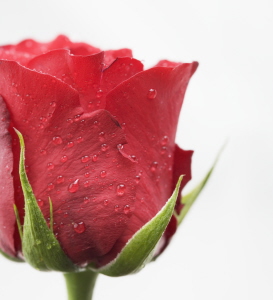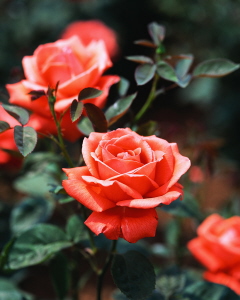|
Tips and Techniques for Rose Growing
For many of us, the act of gardening brings us closer to nature by getting us outdoors and allowing us the opportunity to tend and grow plants that in the absence of our assistance would not be able to survive, let alone thrive. There is a special connection between the growers of roses and their plants, however, which seems to go even beyond the basic instincts of the traditional gardener.
Perhaps some of the addiction we have in cultivating these plants stems in part from the same areas that our ancient forebears found so appealing. Many varieties have a very distinctive scent, and the shape of the flower is certainly unique enough in itself to warrant extensive cultivation and appeal. They also represent a singular species which can manifest itself in a variety of styles, and therefore a gardener really needs only to focus on diffent types to bring all the variety to the appearance of her lawn and garden that could be wished for. They can be planted in the miniature style, as bushes, and as climbers. Lastly, they require as little or as much attention as the gardener wants to put in. Pruned bushes look ideal, but are also beautiful when allowed to grow freely. They also tend to be very hardy and resistant to diseases. The soil composition needs not have too many considerations, and the ground cover is totally up to the gardener. 
5 Tips for Planting
When spring is on its way and the ground is soft, it is the perfect time for planting. Roses have been a very popular bloom over the years, not only do they look good, but they smell wonderful too. However, planting cannot be done just anywhere or in just any climate. They need special care and treatment. Here are some tips that you need to consider in order to successfully grow them: 1. They require about 4 to 6 hours of sunlight everyday. It would be best to plant your roses in a clear area where there are not too many trees or other types of plants. The reason behind this is that they may lack sunlight exposure and the roots are also likely to become intertwined with the plant and throttle its growth. If you wish to replace an old bush, you should remove about 1 ½ cubic feet of the old soil and replace it with new soil so that the newly planted rose will have fresh soil to start with. 2. When thinking about the position of your roses you must consider the type you are planting. Place ramblers and climbers along trellises, fences and next to pergolas or arches. This is important to consider because they need space to grow freely and these positions are perfect for bigger blooming plants. 3. Roses will look good in island beds which can be mixed with perennials. Smaller ones make great edging plants, which are perfect for combining in front of taller species. Dig a hole large enough for the size of the root ball, but remember to loosen the soil in the bottom of the hole. You can also add bone meal which acts as a slow acting resource of phosphorus. This will help establish a healthy root growth for your plants. 4. You should be careful when considering the planting depth as this depends on your climate. If you live in a cooler climate, plant deeper, but if you wish to plant in a pot, you must dig about 1 inch deeper than the usual potting level.
5. Make sure that you place the plant in the hole carefully. The hole should be refilled with soil so that the roots are covered completely. Before you make the final covering, water the plant. Then mound the soil about 8 inches high around the base of the plant. The earth will keep the stems from drying out until the plant is completely rooted. As the leaves open, you can remove the excess soil that surrounds the plant. These are some important tips you need to consider when planting. It will be worth the effort, as your plants will bloom beautifully. Finding the best types of plants can be a confusing task when you consider the multitude of varieties that are available. Here are a few suggestions that will help you produce beautiful plants that are sure to be the envy of the neighbourhood: Ask your local garden centre or nursery about the best types of roses to plant in your particular area. Different climates require different kinds, if you want to achieve outstanding results. If you are a beginner, be sure to choose disease-resistant bushes, as they will require less maintenance and care. You must choose a spot to plant your bushes that is well lit in the mornings and that will receive at least 6 hours of uninterrupted sunlight each day. You must have well-drained soil with a PH level 5.5 to 7.0. You will be able to find a testing kit at your local garden centre. The test kits are quite inexpensive and could save you a lot of difficulties after planting your rose bushes. When planting include plenty of organic matter in the soil surrounding the plants. Make sure the roots of the bush are very damp and well fertilized before you actually plant it. If you are planting roses that have very little soil surrounding the roots, soak the roots in water or puddle clay for several minutes and cut off any roots that are damaged or broken before planting. For the first few weeks after planting, you should water thoroughly and often. When the top two inches of soil surrounding the plant becomes dry, water the ground until it is completely soaked. After your plants have become established, soak your bed approximately every two weeks for best results. If you live in an area that is extremely dry or hot you may consider watering more often. Be careful not to over-water your plants and it is best to water in the early mornings. For the best results, plant bushes in the early spring after any danger of a frost has passed. Also, roses should be planted in an area that is open and gets plenty of air circulation. They do not grow well in a tight or enclosed space. How to Plant Bare Root Stock: 1. Before planting, soak the roots in water overnight. 2. Dig a hole and make a mound of soil in the bottom of it. Set the plant on the mounds, spreading the roots evenly around the mound. 3. Place the plant so the bud union is at the same height as the ground surface. 4. Cover the roots with loose soil and press lightly. Add more soil until the hole is half full, then fill with water, letting the water soak in. 5. Fill the hole with soil, and you're done! Mulching: Mulching your plants is good for any soil and in any climate. It is extremely helpful in dry areas. Mulch keeps the soil temperature steady, and prevents heavy rain from causing the top soil to cake up. Mulching also helps to controls weeds.
Aphids and greenfly problems Check your plants for greenfly; just a few aphids can be dealt with by spraying with soapy water from an atomiser whereas a heavier infestation will require the application of a systemic insecticide or a combination systemic insecticide and fungicide such as "Rose-clear". Some people have questioned whether they have greenfly and whitefly upon discovering what looks like small white insects mixed in with the typical greenfly our roses attract; this is in fact white outer bodies that greenfly shed during their life cycle. An organic and safe black spot spray Now I have already mentioned the product "Rose-clear", this is chemical mix is also commonly used to deal with the other problem our plants encounter, which is black spot. This disease cause leaf loss, and die back. Black spot is encouraged by much the same conditions that encourage potato blight, which are warm, moist conditions. Check your plants leaves for black spots with yellow halos and treat with "Rose-clear" according to the manufacturers instructions paying careful heed to the safety instructions. If you wish to try to prevent black spot on your roses organically and safely, you may only have to go as far as your fridge. Mix equal parts skimmed milk and water, apply this with an atomiser or a sprayer to the upper and lower section of the leaves. This milky solution causes an invisible and friendly fungus to form, which will help prevent the formation of the dreaded black spot. Feeding and fertilising Apart from these treatments, there is another way to help your plants battle pests or diseases and that is to keep their vigour up by proper feeding. Roses benefit from mulching with well-rotted horse dung or garden compost; this will give you bigger blooms, healthier foliage and strength to survive pest and disease attack. A 5 cm (2 inch) layer of this mulch is adequate; do not allow this to touch the stem as it may in some cases lead to rotting. One final benefit of mulching your plants in this way is the reduction of water loss and the suppression of weeds, both of these are very important in a dry summer (we live in hope).
Watering Roses need to receive 1 inch of water per week. What's the best way? Watering deeply once a week, instead of watering lightly more often. Overhead sprinkling is great when done in the morning. This lets the foliage dry out before nightfall. Using soaker hoses or other drip-irrigation systems may be a more convenient way to water your plants. Winter Treatment: It's fairly easy to help most roses get safely through winter. Start by shovelling a protective mound of soil around the base of the plant. Then add a few scoops of mulch around the base, and they should stay well insulated.
Pruning Pruning your plants is an essential part of plant maintenance. There are many ways and opinions on the best way to prune, when the perfect time to prune is, and which ones need pruning. Many seasoned growers have their favourite tested methods. Pruning is not as complicated as some people think. To make it easy, there are 7 basic rules to follow when pruning your plants. If you keep these rules in mind, you will be rewarded with the most beautiful bushes. The first rule in pruning is to remove any dead or dying growth. In doing this, your bushes will look good and will be free from signs of diseases. Removing the deadwood will discourage insects from making your plant their home. Insects love roses so keep an eye out for them while pruning. Second, you should keep the centre of your plant clear. This helps keep your bushes clear from pests and insects and allows good ventilation, which reduces the likelihood of fungus growth and other diseases. Third, it is important to keep your plant away from other bushes so that their growth will not be impaired. If your rose is disturbed or overcrowded by other plants it may not grow, as you wish. Fourth, you must shape your bushes while they are growing. This will prevent them from growing too wildly. If you do this, your plants will grow properly in the right direction. Fifth, you must use sharp pruning shears. This is important so you make a clean cut and don’t affect the areas that you are not pruning. If you use a pruning shear that is not sharp, it may result in uneven branches, which can hinder or result in uneven growth. Sixth, you must clean your pruning shears so they are free from diseases or fungus spores. The shears should be kept dry to prevent rust formation which makes your shears dull. If your shears are not sharp, you will have a hard time cutting the desired parts and will end up damaging the branches. And lastly, you should seal the cuts you have made so that they will be free from disease.
As any rose gardener will tell you, there is nothing in the world more addicting than tending to these plants. They are the most popular flower in the world, and they offer a great option for any landscaping scheme, as they look good both when cared for every single day and also when they are left to their own devices. The first Hybrid Tea was called Le France, and was introduced in 1867 by rose breeder Jean-Baptist Guillot. They were the result of crossing two original China roses with Bourbon and Noisette types. These are considered to be more delicate than the other breeds, and are also the most popular species when it comes to those bought and sold in flower shops. Although Hybrid Teas may be more delicate than other varieties, there are still many breeds available to suit any climate. If you are thinking about planting your own, then it is vital that you look for a species that is suited to the area in which you live. Be aware of the humidity or lack in your area, and choose your plants based on this factor as well as the variations in temperatures. Hot and dry areas will require plants with good root systems and the ability to tolerate heat. Excessive humidity can also be detrimental to some Hybrid Teas, so make sure to find a species that is mildew resistant. Remember when caring for your Hybrid Teas that these plants bloom every couple on months depending on conditions, and thus they will require extra food for optimum health. They need to be fed once every week, starting with the season. Apply a fertilizer that has been designed for the plant, and remember to stop well before the first frost in your area in order to avoid damage to tender new blossoms. As with most garden plants, there are a few basic rules when it comes to watering Hybrid Teas. To preserve water, apply some mulch (this will also help to insulate root systems in colder areas). Also be sure to apply the water to the soil, and not over the plants via a sprinkler or other such device, as this could lead to the growth of mould. Hybrid Teas are the most popular rose in the world, and are a beautiful addition to any garden. Their diversity ensures that they are appropriate to almost any climate.
Return from Rose Growing to Gardening
|





 Rose Growing Tips and Techniques
Rose Growing Tips and Techniques
 The first reason that these can be such an addictive plant is the roots it has in our culture in the form of myth and symbolism.
The first reason that these can be such an addictive plant is the roots it has in our culture in the form of myth and symbolism.  Roses are considered tolerant plants so pruning is important to keep them free from diseases and insects. If you follow these basic rules, your plants will flourish and live for many years. It only takes a little patience and your efforts will be well rewarded.
Roses are considered tolerant plants so pruning is important to keep them free from diseases and insects. If you follow these basic rules, your plants will flourish and live for many years. It only takes a little patience and your efforts will be well rewarded.






